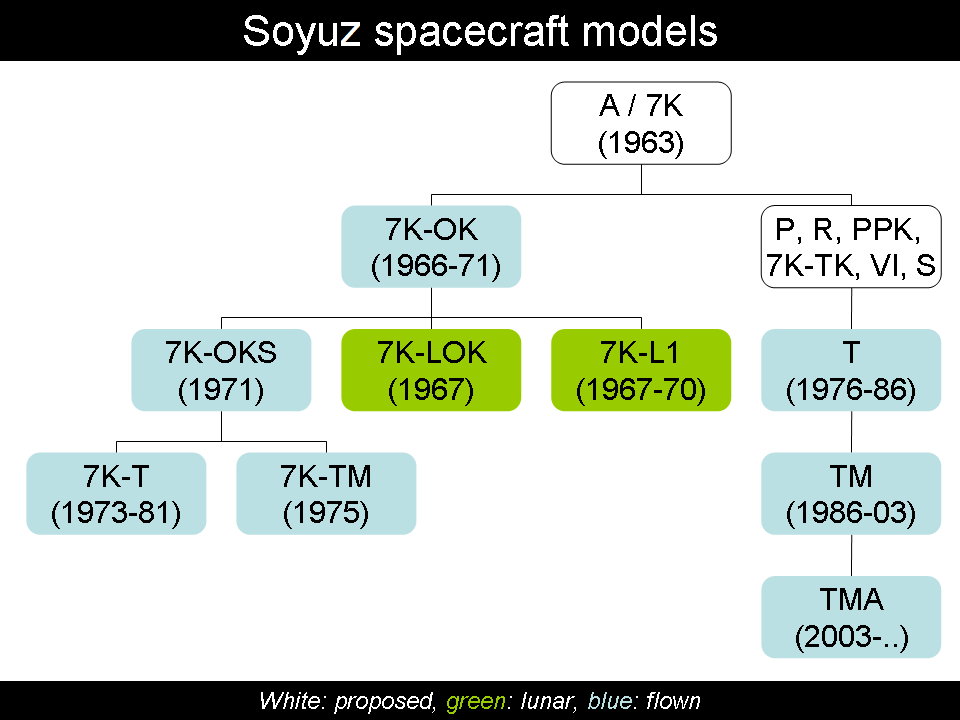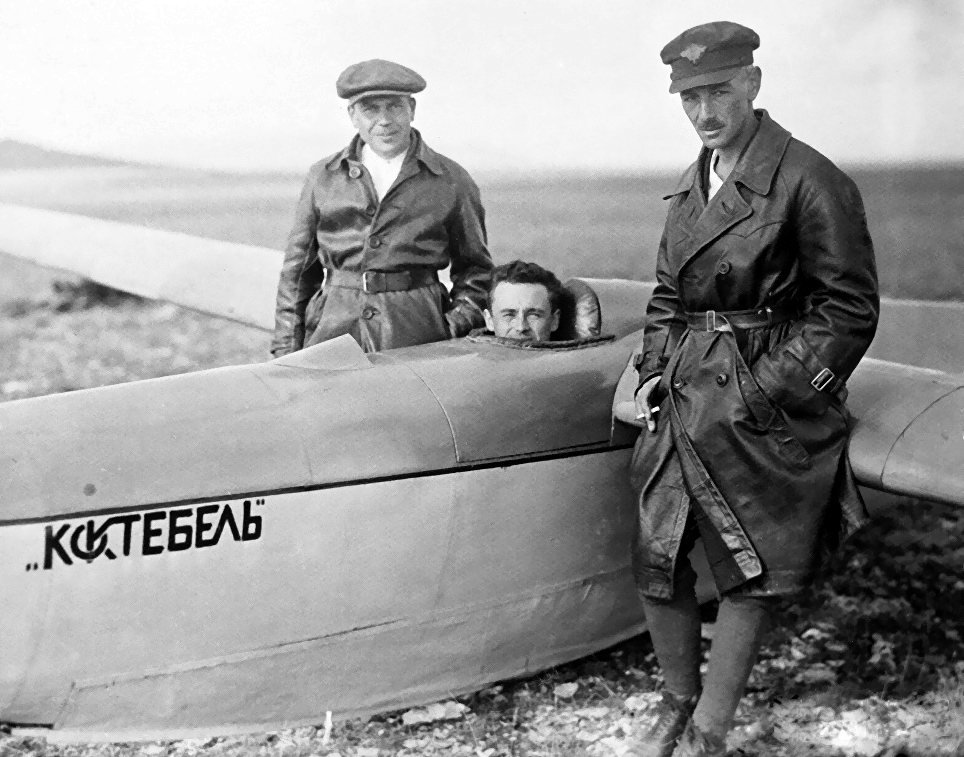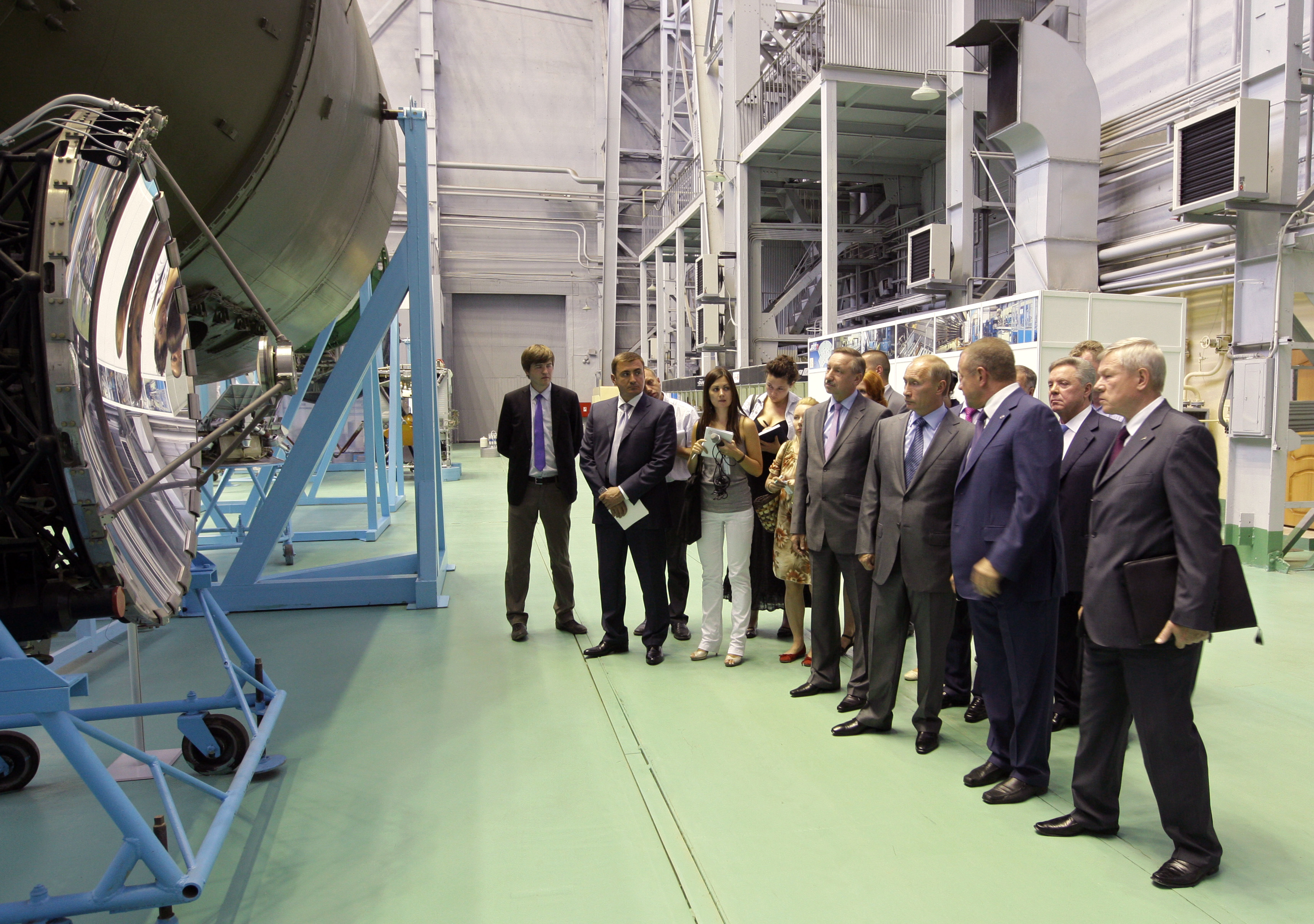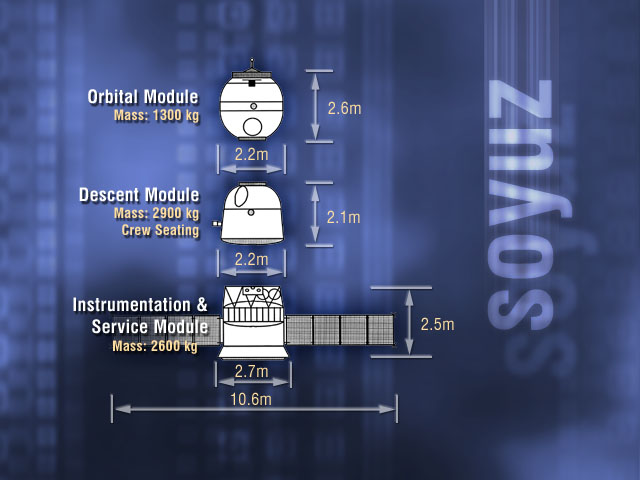|
Soyuz 7K-TK
Soyuz 7K-TK ( meaning Union 7K-TK) was a proposed Soviet spacecraft, which was designed for delivering cosmonauts to Soyuz R piloted military stations. This Soyuz version was equipped with both rendezvous and docking equipment was the basis for the Soyuz 7K-OKS space station ferry which flew two crewed flights in 1971. Because Sergei Korolev, head of the OKB-1 bureau, had died in surgery in January 1966, the Soyuz 7K-R project was cancelled. Potential was still seen in the Soyuz 7K-TK, and so control of the project was handed over to Vladimir Chelomey's bureau to be developed as a transport spacecraft for the Almaz program. Due to the delays in the Almaz program, further development of the 7K-TK was suspended in December 1966. It was expected that the first 7K-TK/Almaz complex would be tested uncrewed in 1968 and would fly crewed thereafter in 1969. However, due to further delays and the Chelomey's preference of the TKS spacecraft in June 1970, the Soyuz 7K-TK program was cancell ... [...More Info...] [...Related Items...] OR: [Wikipedia] [Google] [Baidu] |
Soviet Union
The Union of Soviet Socialist Republics. (USSR), commonly known as the Soviet Union, was a List of former transcontinental countries#Since 1700, transcontinental country that spanned much of Eurasia from 1922 until Dissolution of the Soviet Union, it dissolved in 1991. During its existence, it was the list of countries and dependencies by area, largest country by area, extending across Time in Russia, eleven time zones and sharing Geography of the Soviet Union#Borders and neighbors, borders with twelve countries, and the List of countries and dependencies by population, third-most populous country. An overall successor to the Russian Empire, it was nominally organized as a federal union of Republics of the Soviet Union, national republics, the largest and most populous of which was the Russian SFSR. In practice, Government of the Soviet Union, its government and Economy of the Soviet Union, economy were Soviet-type economic planning, highly centralized. As a one-party state go ... [...More Info...] [...Related Items...] OR: [Wikipedia] [Google] [Baidu] |
Low Earth Orbit
A low Earth orbit (LEO) is an geocentric orbit, orbit around Earth with a orbital period, period of 128 minutes or less (making at least 11.25 orbits per day) and an orbital eccentricity, eccentricity less than 0.25. Most of the artificial objects in outer space are in LEO, peaking in number at an altitude around , while the farthest in LEO, before medium Earth orbit (MEO), have an altitude of 2,000 km, about one-third of the Earth radius, radius of Earth and near the beginning of the Van Allen radiation belt#Inner belt, inner Van Allen radiation belt. The term ''LEO region'' is used for the area of space below an altitude of (about one-third of Earth's radius). Objects in orbits that pass through this zone, even if they have an apogee further out or are sub-orbital spaceflight, sub-orbital, are carefully tracked since they present a collision risk to the many LEO satellites. No human spaceflights other than the lunar missions of the Apollo program (1968-1972) have gone beyond L ... [...More Info...] [...Related Items...] OR: [Wikipedia] [Google] [Baidu] |
Soviet Space Program
The Soviet space program () was the state space program of the Soviet Union, active from 1951 until the dissolution of the Soviet Union in 1991. Contrary to its competitors (NASA in the United States, the European Space Agency in Western Europe, and the Ministry of Aerospace Industry in China), which had their programs run under single coordinating agencies, the Soviet space program was divided between several internally competing OKB, design bureaus led by Sergei Korolev, Korolev, Kerim Kerimov, Kerimov, Mstislav Keldysh, Keldysh, Mikhail Yangel, Yangel, Valentin Glushko, Glushko, Vladimir Chelomey, Chelomey, Viktor Makeyev, Makeyev, Boris Chertok, Chertok and Information Satellite Systems Reshetnev, Reshetnev. Several of these bureaus were subordinated to the Ministry of General Machine-Building. The Soviet space program served as an important marker of claims by the Soviet Union to its superpower status. Soviet rocketry, Soviet investigations into rocketry began with the fo ... [...More Info...] [...Related Items...] OR: [Wikipedia] [Google] [Baidu] |
Soyuz 7K-OKS
Soyuz 7K-OKS (also known as Soyuz 7KT-OK) is a version of the Soyuz spacecraft and was the first spacecraft designed for space station flights. Its only crewed flights were conducted in 1971, with Soyuz 10 and Soyuz 11. Design The two craft of the Soyuz 7K-OKS generation were modified from the original Soyuz 7K-OK. The new "probe and drogue" docking mechanism, which was first used by these two missions, featured an internal docking hatch that allowed for the first time internal transfer between Soviet spacecraft. This "probe and drogue" docking mechanism introduced with Soyuz 7K-OKS is still in use today at the International Space Station (ISS). The external toroidal fuel tank, a holdover from the original lunar mission models of the Soyuz, was dropped from the 7K-OKS since it was unneeded for Earth orbital flights. Flights The Soyuz 7K-OKS flew only twice, Soyuz 10 and Soyuz 11. On its maiden flight, the Soyuz 7K-OKS successfully launched into Earth orbit, but faile ... [...More Info...] [...Related Items...] OR: [Wikipedia] [Google] [Baidu] |
Military Soyuz
file:Soyuz 7K-OK(A) drawing.png, Soyuz 7K-OK spacecraft with an active docking unit The Soviet Union planned several military Soyuz spacecraft models. These versions were named Soyuz P, Soyuz PPK, Soyuz R, Soyuz 7K-VI, and Soyuz OIS (Orbital Research Station). However, none of the spacecraft ever flew in space. Soyuz P, R and PPK Soyuz P The Soyuz P (''Perekhvatchik'', Interceptor) space interceptor and Soyuz R (''Razvedki'', intelligence) command-reconnaissance spacecraft was proposed in December 1962 by Sergei Korolev. In the initial draft project, the Soyuz P would use the Soyuz-B, Soyuz 9K rocket stage and Soyuz-V, Soyuz 11K tanker spacecraft to conduct a series of dockings and re-fueling operations. The complete complex would then conduct intercepts of enemy satellites in orbits up to 6,000 km in altitude. Soyuz P was cancelled in 1963. Soyuz R The Soyuz-R system (1963-1966) consisted of two separately launched spacecraft, including the small orbital station 11F7 ... [...More Info...] [...Related Items...] OR: [Wikipedia] [Google] [Baidu] |
Sergei Korolev
Sergei Pavlovich Korolev (14 January 1966) was the lead Soviet Aerospace engineering, rocket engineer and spacecraft designer during the Space Race between the United States and the Soviet Union in the 1950s and 1960s. He invented the R-7 Semyorka, R-7 Rocket, Sputnik 1, and was involved in the launching of Laika, Sputnik 3, the first luna 2, human-made object to make contact with another celestial body, Soviet space dogs#Belka and Strelka, Belka and Strelka, the first human being, Yuri Gagarin, into space, Voskhod 1, and the first person, Alexei Leonov, to conduct a Voskhod 2, spacewalk. Although Korolev trained as an aircraft designer, his greatest strengths proved to be in design integration, organization and strategic planning. Arrested on a false official charge as a "member of an anti-Soviet counter-revolutionary organization" (which would later be reduced to "saboteur of military technology"), he was imprisoned in 1938 for almost six years, including a few months in a K ... [...More Info...] [...Related Items...] OR: [Wikipedia] [Google] [Baidu] |
OKB-1
S.P. Korolev Rocket and Space Corporation "Energia" () is a Russian manufacturer of spacecraft and space station components. Its name is derived from the Russian word for energy and is also named for Sergei Korolev, Sergei Pavlovich Korolev, the first chief of its design bureau and the driving force behind early Soviet accomplishments in space exploration. Overview Energia is the largest company of the Russian space industry and one of its key players. It is responsible for all operations involving human spaceflight and is the lead developer of the Soyuz (spacecraft), Soyuz and Progress (spacecraft), Progress spacecraft, and the lead developer of the Russian end of the International Space Station (ISS). In the mid-2000s, the company employed 22,000–30,000 people. The enterprise has been awarded 4 Order of Lenin, Orders of Lenin, Order of the October Revolution and Russian Federation President's Message of Thanks. In addition, 14 cosmonauts employed by the company have been ... [...More Info...] [...Related Items...] OR: [Wikipedia] [Google] [Baidu] |
Vladimir Chelomey
Vladimir Nikolayevich Chelomey or Chelomei (, ; 30 June 1914 – 8 December 1984) was a Soviet people, Soviet engineer and designer in the missile program of the former Soviet Union. He invented the first Soviet Pulsejet, pulse jet engine and was responsible for developing the world's first anti-ship cruise missiles and the ICBM program of the Soviet Union such as the UR-100, UR-200, UR-500 and UR-700. Early life Chelomey was born to a Ukrainian family in Siedlce, Lublin Governorate, Russian Empire (now Poland). At the age of three months, his family fled to Poltava, Ukraine, when the Eastern Front (World War I), Eastern Front of World War I came close to Siedlce. When Chelomey was 12 years old, the family moved again to Kyiv. In 1932, Chelomey was admitted to the Kyiv Polytechnic Institute (later the basis of Kyiv Aviation Institute), where he showed himself as a student with outstanding talent. In 1936, his first book ''Vector Analysis'' was published. Studying at the insti ... [...More Info...] [...Related Items...] OR: [Wikipedia] [Google] [Baidu] |
Almaz
The Almaz () program was a highly secret Soviet Union, Soviet military space station program, begun in the early 1960s. Three crewed military reconnaissance stations were launched between 1973 and 1976: Salyut 2, Salyut 3 and Salyut 5. To cover the military nature of the program, the three launched Almaz stations were designated as civilian Salyut programme, Salyut space stations. Salyut 2 failed shortly after achieving orbit, but Salyut 3 and Salyut 5 both conducted successful crewed testing. Following Salyut 5, the Ministry of Defense (Soviet Union), Soviet Ministry of Defense judged in 1978 that the time and resources consumed by station maintenance outweighed the benefits relative to automatic reconnaissance satellites. Still, it had some achievements along with the Salyut program, the heritage of the twin program continues, with the International Space Station module Zarya (ISS module), Zarya being one example. The space stations' cores were known internally as OPS (, M ... [...More Info...] [...Related Items...] OR: [Wikipedia] [Google] [Baidu] |
TKS Spacecraft
The TKS spacecraft (, , ''Transport Supply Spacecraft'', GRAU index 11F72) was a Soviet spacecraft conceived in the late 1960s for resupply flights to the military Almaz space station. The spacecraft was designed for both crewed and autonomous uncrewed cargo resupply flights, but was never used operationally in its intended role – only four test missions were flown (including three that docked to Salyut space stations) during the program. The Functional Cargo Block (FGB) of the TKS spacecraft later formed the basis of several space station modules, including the Zarya FGB module on the International Space Station. The TKS spacecraft consisted of two spacecraft mated together, both of which could operate independently: * The VA spacecraft (known mistakenly in the West as the ''Merkur spacecraft''), which would have housed the cosmonauts during launch and reentry of a TKS spacecraft, while traveling to and from an Almaz space station. * And the Functional Cargo Block (FGB) ... [...More Info...] [...Related Items...] OR: [Wikipedia] [Google] [Baidu] |
Soyuz Programme
The Soyuz programme ( , ; , meaning "Union") is a human spaceflight programme initiated by the Soviet Union in the early 1960s. The Soyuz spacecraft was originally part of a Moon landing project intended to put a Soviet cosmonaut on the Moon. It was the third Soviet human spaceflight programme after the Vostok (1961–1963) and Voskhod (1964–1965) programmes. The programme consists of the Soyuz capsule and the Soyuz rocket and is now the responsibility of Roscosmos. After the retirement of the Space Shuttle in 2011, the Soyuz was the only way for humans to get to the International Space Station (ISS) until 30 May 2020 when Crew Dragon flew to the ISS for the first time with astronauts. Soyuz rocket The launch vehicles used in the Soyuz expendable launch system are manufactured at the Progress State Research and Production Rocket Space Center (TsSKB-Progress) in Samara, Russia. As well as being used in the Soyuz programme as the launcher for the crewed Soyuz spacecr ... [...More Info...] [...Related Items...] OR: [Wikipedia] [Google] [Baidu] |
Soyuz (spacecraft)
Soyuz () is a series of spacecraft which has been in service since the 1960s, having made more than 140 flights. It was designed for the Soviet space program by the Korolev Design Bureau (now Energia (corporation), Energia). The Soyuz succeeded the Voskhod spacecraft and was originally built as part of the Soviet crewed lunar programs. It is launched atop the similarly named Soyuz (rocket family), Soyuz rocket from the Baikonur Cosmodrome in Kazakhstan. Following the Soviet Union's dissolution, Roscosmos, the Russian space agency, continued to develop and utilize the Soyuz. Between the Space Shuttle retirement, Space Shuttle's 2011 retirement and the SpaceX Crew Dragon's 2020 debut, Soyuz was the sole means of crewed transportation to and from the International Space Station, a role it continues to fulfill. The Soyuz design has also influenced other spacecraft, including China's Shenzhou (spacecraft), Shenzhou and Russia's Progress (spacecraft), Progress cargo vehicle. The Soyu ... [...More Info...] [...Related Items...] OR: [Wikipedia] [Google] [Baidu] |








